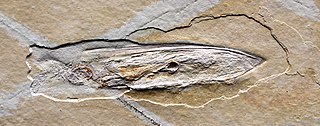In the geologic timescale, the Callovian is an age and stage in the Middle Jurassic, lasting between 166.1 ± 4.0 Ma and 163.5 ± 4.0 Ma. It is the last stage of the Middle Jurassic, following the Bathonian and preceding the Oxfordian.

Antrodemus is a dubious genus of theropod dinosaur from the Kimmeridgian-Tithonian age Upper Jurassic Morrison Formation of Middle Park, Colorado. It contains one species, Antrodemus valens, first described and named as a species of Poekilopleuron by Joseph Leidy in 1870.

Aulacostephanus is an extinct ammonoid cephalopod genus from the Upper Jurassic Tithonian belonging to the perisphinctacean family Aulacostephanidae.
Oecotraustes is an extinct cephalopod genus included in the ammonid family Oppeliidae and named by Waagen in 1869. The genus lived during the Middle Jurassic.
Oecoptychius is an extinct genus of fossil ammonite cephalopods. The species lived during the Middle Jurassic.

Hulettia is an extinct genus of prehistoric bony fish found in the Morrison Formation in the western United States, measuring approximately three to four inches in length. This fish genus contains one species, H. americana. Its body was covered in thick prominent scales, and its name is based on Hulett, Wyoming, a locale which is near the Morrison Formation. Discovered specimens show evidence of predation upon the smaller species of fish Todiltia that inhabited the Jurassic Lake Todilto, and another specimen discovered in the Bathonian coastal sandstone, in the Sundance Formation of South Dakota. Both specimens are complete skeletons with no fragmentary remains or dubious anomalies amongst the bones recovered.

Orthocormus is an extinct genus of prehistoric pachycormiform bony fish. It is known from three species found in Kimmeridgian aged plattenkalk deposits in Bavaria, Germany. The species "Hypsocormus" tenuirostris Woodward 1889 from the late Middle Jurassic (Callovian) Oxford Clay is not closely related to the type species of Hypsocormus, and is more closely related to Orthocormus + Protosphyraena, and thus has sometimes been referred to in open nomenclature as Orthocormus? tenuirostris.

Cenoceras is an extinct genus within the cephalopod mollusc family Nautilidae, which in turn makes up part of the superfamily Nautilaceae. This genus has been described by Hyatt in 1884. The type species is Cenoceras intermedium (Sowerby).

Peroniceras is an ammonite belonging to the Ammonitida family Collignoniceratidae.

Trigonia is an extinct genus of saltwater clams, fossil marine bivalve mollusk in the family Trigoniidae. The fossil range of the genus spans the Paleozoic, Mesozoic and Paleocene of the Cenozoic, from 298 to 56 Ma.

Pterotrigonia is an extinct genus of saltwater clams, marine bivalve molluscs in the family Megatrigoniidae. This genus is known in the fossil record from the Jurassic period Tithonian age to the Cretaceous period Maastrichtian age. Species in this genus were facultatively mobile infaunal suspension feeders. The type species of the genus is Pterotrigonia cristata.

Protetragonites is an extinct genus of ammonoid cephalopods belonging to the family Lytoceratidae. These fast-moving nektonic carnivores lived from the Jurassic period Tithonian age to the Cretaceous period Aptian age.

Harpoceras is an extinct genus of ammonite belonging to the family Hildoceratidae. These cephalopods existed in the Jurassic period, during the Toarcian age from the Falciferum zone to the Commune subzone of the Bifrons zone. They were fast-moving nektonic carnivores.

Lithacoceras is an extinct Ammonite cephalopod genus included in the superfamily Perisphinctoidea. These fast-moving nektonic carnivores lived during the Jurassic period, from the Oxfordian age to the Tithonian age.

Pseudopeltoceras is a genus of perisphinctoid ammonites belonging to the family Perisphinctidae.

Parkinsonia is a genus of ammonites belonging to the family Parkinsoniidae.

Skirroceras bayleanum is a Stephanoceratacean (ammonite) species belonging to the family Stephanoceratidae.

Skirroceras macrum is a Stephanoceratacean (ammonite) species belonging to the family Stephanoceratidae.

Plesioteuthis is an extinct genus of squids, belonging to the family Plesioteuthididae. This genus was first described in 1859, and its fossils were found in the well-known Solnhofen field in Germany.

Mercaticeras is an extinct genus of ammonites belonging to the family Hildoceratidae.

















